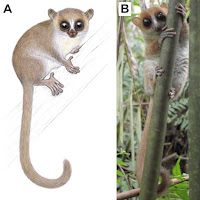Highlights:
- Two pairs of Microcebus species occur in partial sympatry.
- Morphological distinctiveness supports genomic species delimitation in cryptic lemurs.
- High plasticity in reproductive schedules in a lineage of habitat generalists detected.
Abstract
Delimitation of cryptic species is increasingly based on genetic analyses but the integration of distributional, morphological, behavioral, and ecological data offers unique complementary insights into species diversification. We surveyed communities of nocturnal mouse lemurs (Microcebus spp.) in five different sites of northeastern Madagascar, measuring a variety of morphological parameters and assessing reproductive states for 123 individuals belonging to five different lineages. We documented two different non‐sister lineages occurring in sympatry in two areas. In both cases, sympatric species pairs consisted of a locally restricted (M. macarthurii or M . sp. #3) and a more widespread lineage (M. mittermeieri or M. lehilahytsara). Estimated Extents of Occurrence (EOO) of these lineages differed remarkably with 560 and 1,500 km2 versus 9,250 and 50,700 km2, respectively. Morphometric analyses distinguished unambiguously between sympatric species and detected more subtle but significant differences among sister lineages. Tail length and body size were most informative in this regard. Reproductive schedules were highly variable among lineages, most likely impacted by phylogenetic relatedness and environmental variables. While sympatric species pairs differed in their reproductive timing (M. sp. #3/M. lehilahytsara and M. macarthurii/M. mittermeieri), warmer lowland rainforests were associated with a less seasonal reproductive schedule for M. mittermeieri and M. lehilahytsara compared with populations occurring in montane forests. Distributional, morphological, and ecological data gathered in this study support the results of genomic species delimitation analyses conducted in a companion study, which identified one lineage, M. sp. #3, as meriting formal description as a new species. Consequently, a formal species description is included. Worryingly, our data also show that geographically restricted populations of M. sp. #3 and its sister species (M. macarthurii) are at high risk of local and perhaps permanent extinction from both deforestation and habitat fragmentation.
Keywords: conservation, cryptic species, evolution, habitat use, phenotype, sympatry
Systematics
Order: Primates (Linnaeus 1758)
Suborder: Strepshirrini (É. Geoffroy 1812)
Family: Cheirogaleidae (Gray 1873)
Genus: Microcebus (É. Geoffroy 1828)
Microcebus jonahi species nova
Habitat information: M. jonahi individuals were captured at altitudes between 42 and 356 m a.s.l. Out of the 25 captured individuals, six were caught in near‐primary forest (= low degradation) with a rather continuous canopy and five were captured in highly degraded forests with discontinuous canopy cover and strong regrowth of early successional trees. The majority of individuals (N = 14) were captured in 2–4 m high stands of the perennial Madagascar cardamom (Aframomum angustifolium), sometimes intermixed with trees along the forest edges. At Antanambe (Figure 1), a total of 39 individuals were sighted of which 35 were found in forest habitats of different degradation stages. No M. jonahi were sighted in treeless secondary vegetation except for dense Aframomum angustifolium habitats. It currently inhabits one protected area (Mananara‐Nord NP) and a community managed forest area around the village of Ambavala (Schüßler et al., 2018).
Diagnosis:
M. jonahi can be distinguished from other taxa in northeastern Madagascar by morphometric features and genomic distinctiveness. Compared with its closest relative, M. macarthurii, M. jonahi is longer, has a shorter tail, wider ears, a larger head width and a shorter head length. In addition, M. jonahi can be differentiated from M. macarthurii by its ventral coloration which is rather whitish (Figure 6), but distinctly yellowish orange in M. macarthurii (Radespiel et al., 2008; Radespiel & Raveloson, unpublished data).
Moreover, it can be easily distinguished from the sympatric, small‐bodied M. lehilahytsara (at Ambavala) by its higher body mass, larger body size, and longer tail length. Finally, M. jonahi can be differentiated from its southern geographical neighbor, M. simmonsi, by its shorter ear length and its larger inter‐ and intraorbital distances. M. jonahi could be unambiguously distinguished from the other four taxa in this study across all analyses of nuclear RADseq data (Poelstra et al., 2020). However, it may not be reliably distinguished from M. macarthurii based solely on mitochondrial sequences, likely due to some introgression from M. jonahi into M. macarthurii in the past (Poelstra et al., 2020).
Etymology: M. jonahi is named in honor of Malagasy primatologist Professor Jonah Ratsimbazafy. He has dedicated his life's work to the conservation of Malagasy lemurs. With both national and international outreach to the scientific community (e.g., GERP, IPS, LemursPortal), to the public of Madagascar (e.g., by initiating the World Lemur Festival), and to the political leaders of Madagascar, he serves as an inspirational role model for young Malagasy students and scientists. He provides hope for the future of Madagascar and for its iconic lemurs during very challenging times.
Vernacular name: English name: Jonah's mouse lemur, French name: Microcèbe de Jonah, German name: Jonah's Mausmaki.
Dominik Schüßler, Marina B. Blanco, Jordi Salmona, Jelmer Poelstra, Jean B. Andriambeloson, Alex Miller, Blanchard Randrianambinina, David W. Rasolofoson, Jasmin Mantilla‐Contreras, Lounès Chikhi, Edward E. Louis Jr., Anne D. Yoder and Ute Radespiel. 2020. Ecology and Morphology of Mouse Lemurs (Microcebus spp.) in A Hotspot of Microendemism in northeastern Madagascar, with the Description of A New Species. American Journal of Primatology. DOI: 10.1002/ajp.23180




